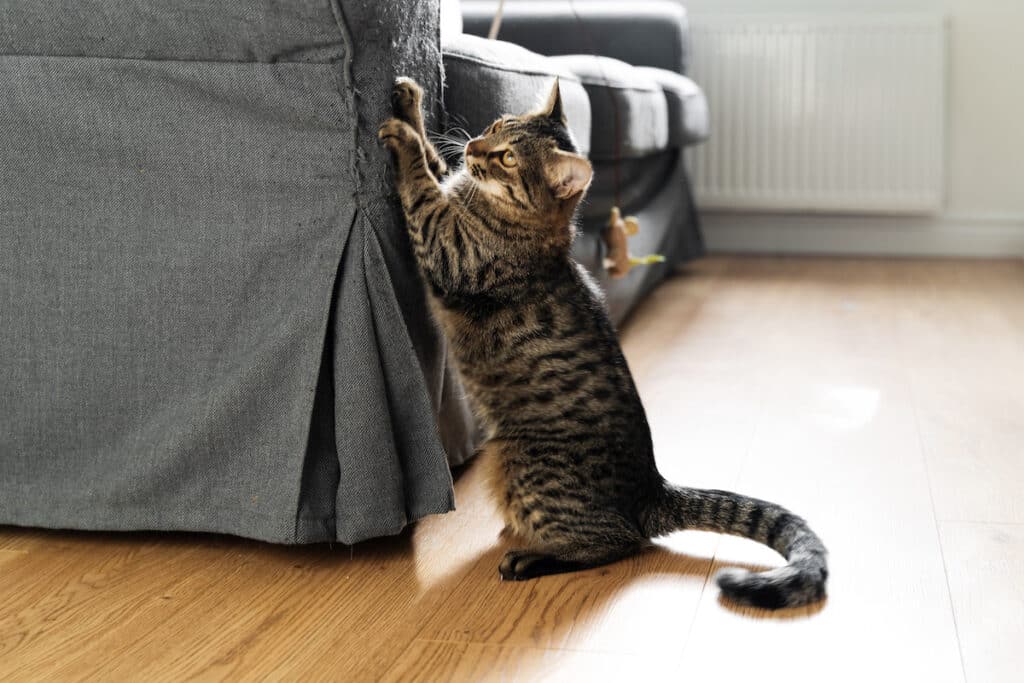When you awaken to discover fresh claw prints left by your cat while you slept, we understand how you feel. It can be, to put it mildly, discouraging. You undoubtedly worry that guests will be perplexed by all the scratches on your sofa. What can you do to prevent your kitty companion from damaging the new couch now that you want to get a new one?
How to Stop My Cat From Scratching the Furniture
While cats may require scratching to remain calm and healthy, you no longer want them to trample on your expensive furniture or other possessions. Here are some strategies to get your cat to quit scratching your furniture:
- Get some scratching posts and toys: Provide your cat with at least one suitable scratching post. Make sure to pick posts that are sturdy, tall, and made of a material that facilitates scratching by cats, such as sisal cloth. This is crucial because cats can disregard your scratching post if it doesn’t have a surface they can scratch on.
- Position your scratching posts: Place the posts in areas where your cat enjoys relaxing or playing. These include spaces near windows and the family room. After waking up, cats like stretching and scratching, so keep a cat close to where they often sleep. Place one close to any furniture that they tend to scratch. Each post needs to be placed in an obvious location where your cat can use it to define their territory.
- Discourage the cat from scratching couches and other furniture: To prevent the cat from getting to the scratched area, you can do this by tucking a sheet around it. To cover the area, you can alternatively use aluminum foil or double-sided tape. Another approach is to spray a citrus-scented fragrance on the couch, as cats don’t enjoy the aroma of citrus.
- Encourage your cats to scratch the posts: On the posts, smear catnip or spray honeysuckle. The cat will be drawn to this and become more enthusiastic about scratching the posts. Another option is to play with a wand toy next to a post, then put the toy on the post so the cat will find it and scratch it.
- Redirect bad scratching: Make a loud noise to divert your cat from inappropriate scratching behavior and direct them to a scratching post. Give them food or catnip as positive reward when they scratch a post.
- Maintain your cat’s claws: Maintaining your cat’s claws is a crucial step in reducing scratching. Uncontrolled claw growth can hurt and occasionally infect your cat’s paw pad. Every few weeks, trim your cat’s claws to prevent them from becoming too long.
Why Does My Cat Scratch So Much?
You should understand why your cat scratches your furniture before making any attempts to train it to stop. Cats scratch surfaces to:
- Stretch their bodies: Cats need to regularly exercise their muscles, which they may do by scratching.
- Mark out territories: In between each of a cat’s paws are smell glands. The glands produce smells that they might use to mark the limits of their territory whenever they scratch something.
- Keep healthy claws: Your cat may remove the old layers from the tips of its claws by scratching. The claws remain healthy and sharp as a result.
- To relieve stress: Cats may release tension by scratching, and it also helps them avoid harmful habits like reckless defecation.
Can I Declaw My Cat?
Despite the fact that cat scratching might be a bothersome problem, declawing your cat is not a smart move. Declawing is frequently viewed by pet owners as a quick, simple repair. Declawing your cat can actually lead to significant, lifelong problems. With the exception of a malignant nail bed tumor, the Humane Society of the United States opposes cat declawing.
There are a lot of good reasons not to declaw kittens and cats. Cats naturally scratch to feel protected and secure, and they rely on their claws to do so. Declawing, which involves amputating the terminal bone of each toe, is not a little trim. It’s like having every finger severed at the last knuckle. There is no medical advantage for the cat from this serious procedure. It actually has a number of ways to hurt the cat. The following problems may result from declawing your cat:
- Physical pain: The paw hurts after declawing. This frequently goes beyond the standard recuperation time following surgery. Following declawing, many cats continue to experience pain. Muscle soreness can also result from not being able to stretch out their muscles while scratching.
- Infection: There is a substantial danger of infection if each toe has a significant wound. After getting their claws removed, many cats develop life-threatening and agonizing infections.
- Bone spurs and nerve damage: Claw removal is an intrusive procedure, thus mistakes can happen. Bone spurs and painful nerve injury are common in cats.
- Aggressive behavior: Cats protect themselves by using their claws. As a result of frequently feeling unsafe, a cat without claws may act aggressively and defensively. Cats with dew claws could bite more frequently.
- Refusal to use the litter box: Owners of cats must switch out litter for shredded newspaper for at least a week or two following the declawing procedure since litter will irritate the animals’ wounds. Some cats avoid the litter box over the long run due to the discomfort they experience when clawing in it and the unfamiliarity. Declawing can stop housebreaking in this way.
- Lameness: Declawing can cause chronic discomfort and other issues that can leave cats permanently crippled. Some people have a persistent limp.
Simply put, the risk is not worth it. Declawing may appear to be a simple solution to scratching difficulties, but it really results in a number of other, more serious problems. Tendonectomy is an alternative to conventional declawing that you may have heard of. The tendons that govern the claws in each toe must be severed during this treatment. This is not advised because it is just as risky and painful for the cat as declawing.
Instead of subjecting your cat to a painful, dangerous, and harmful medical procedure, try working with them to reduce excessive scratching. Cats must be able to scratch and have access to their claws. You can stop bad scratching by enticing your cat to utilize scratching posts and caring for your cat’s claws.
What Can I Do If My Cat Won’t Stop Scratching?
Use nail caps if none of these suggestions have helped your cat stop clawing furniture and other unwelcome objects in your home. These shield priceless surfaces from harm and are typically composed of vinyl.
stop your cat from scratching the furniture stop your cat from scratching the furniture stop your cat from scratching the furniture stop your cat from scratching the furniture stop your cat from scratching the furniture stop your cat from scratching the furniture stop your cat from scratching the furniture stop your cat from scratching the furniture stop your cat from scratching the furniture stop your cat from scratching the furniture stop your cat from scratching the furniture stop your cat from scratching the furniture stop your cat from scratching the furniture














